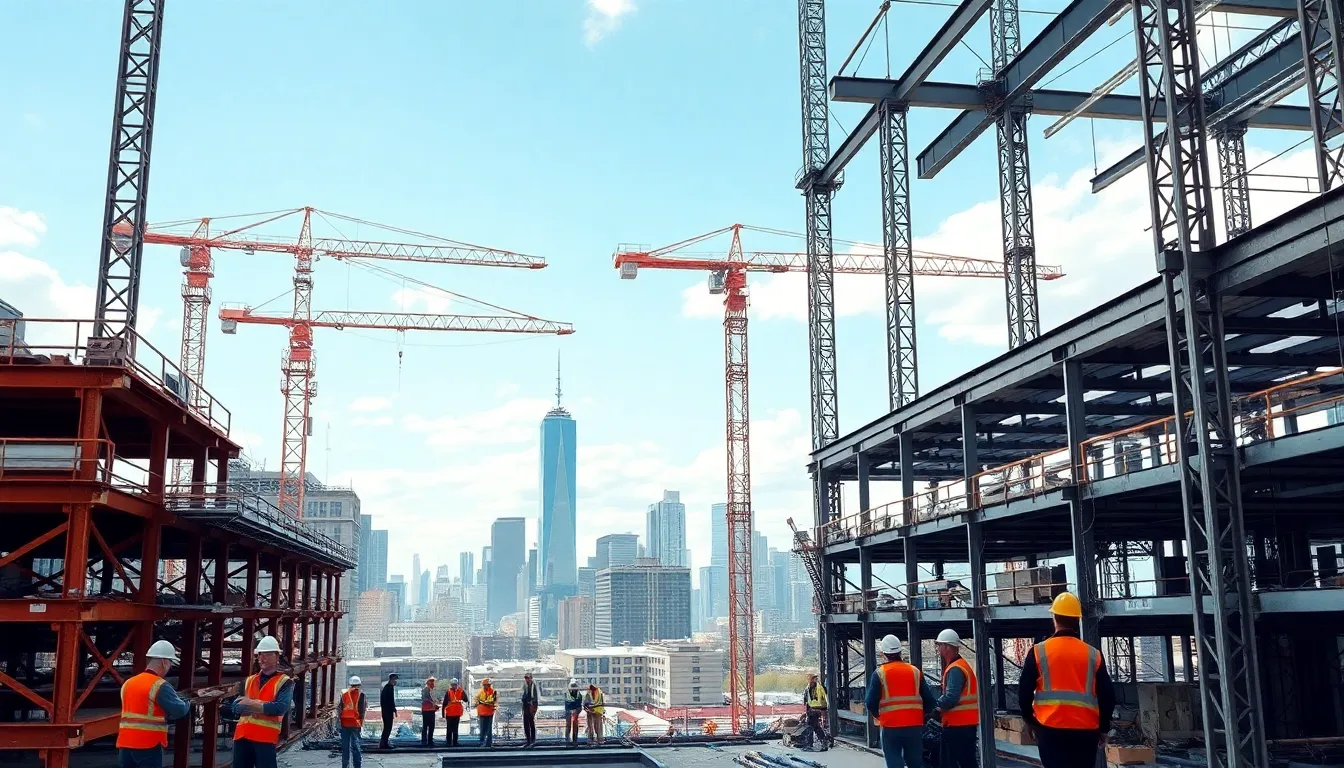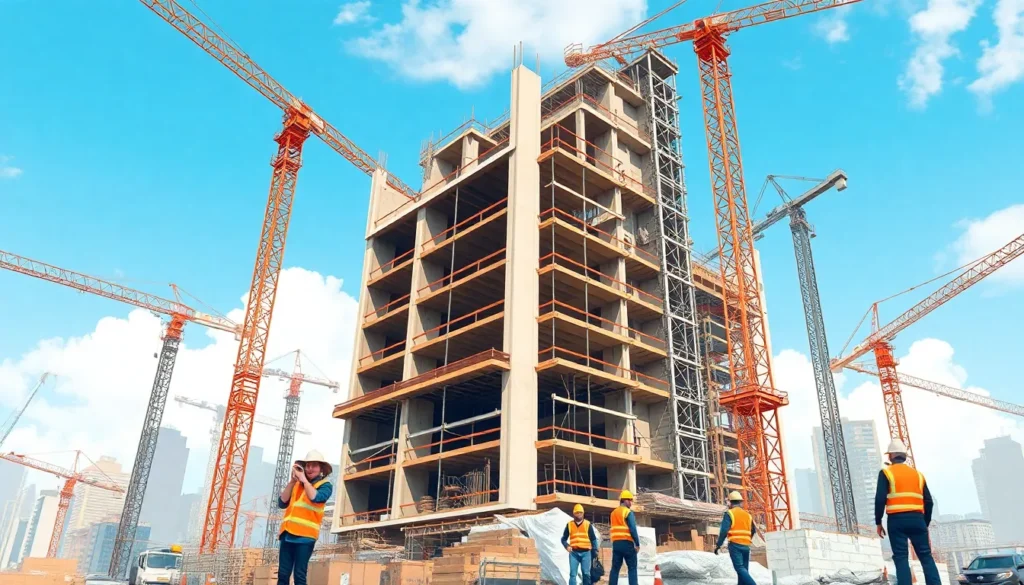Ever walked past a building site and thought, “Wow, that looks like a scene from a sci-fi movie”? Under construction buildings have a way of sparking curiosity and imagination. They’re the awkward teenagers of architecture—full of potential but still figuring things out. From towering skyscrapers to cozy cafes, these sites represent dreams in progress, waiting to unveil their true identities.
But it’s not just about the chaos of cranes and concrete. There’s a fascinating story behind every construction project, filled with innovation, design challenges, and a sprinkle of humor. As they rise from the ground, these structures promise to transform our urban landscapes and redefine our experiences. So let’s dive into the world of construction, where every beam and brick has a tale to tell, and where the only thing more exciting than the finished product is the journey to get there.
Table of Contents
ToggleOverview of Under Construction Buildings
Under construction buildings embody the dynamic nature of architectural development. New structures arise from the ground up, representing significant investments in urban infrastructure. Skyscrapers, homes, and commercial venues contribute to the evolving skyline, enhancing the character of cities. Various stages exist in construction, including planning, excavation, and framing; each stage leads toward completion.
Current statistics indicate construction spent in the United States reached $1.57 trillion in 2022. The commercial sector accounted for about 45% of this total, with new office spaces and shopping centers dominating. Building types range from residential apartments to high-rise mixed-use developments, with each project facing unique challenges and timelines.
Innovation plays a vital role in the process. Sustainable building practices gain popularity, improving energy efficiency and reducing waste. Modular construction techniques allow for faster assembly, streamlining timelines and decreasing costs. Safety regulations ensure workers’ well-being amidst on-site hazards, with compliance mandatory for all active projects.
Design challenges arise as architects balance aesthetics with functionality. Collaboration between multiple stakeholders, including engineers, contractors, and city planners, fosters a comprehensive approach to building. By addressing potential issues early in the project, teams can mitigate delays and stay within budget.
Curiosity often surrounds construction sites. The sight of cranes, scaffolding, and cement mixers captures the imagination, hinting at the future of the space. Each construction site reveals a story, from the vision of the architects to the labor of the workers. Embracing this journey means acknowledging both the complexities and the possibilities that under construction buildings embody.
Importance of Under Construction Buildings

Under construction buildings play a crucial role in shaping communities and enhancing economies. These structures symbolize growth and progress, impacting urban environments.
Economic Impact
Construction projects significantly contribute to local economies. The National Association of Home Builders states that each new construction job generates approximately three additional jobs in related sectors. Increased spending on materials and labor stimulates demand, leading to a ripple effect throughout the economy. Investing in infrastructure supports local businesses by increasing foot traffic and accessibility. New developments, such as commercial spaces, often boost property values, enhancing tax revenues for municipalities. Additionally, construction projects provide numerous job opportunities, reducing unemployment rates in the area.
Urban Development
Urban development thrives with the introduction of under construction buildings. Expanding infrastructure provides essential services and amenities to growing populations. Designing mixed-use developments fosters vibrant communities by integrating residential, commercial, and recreational spaces. Such initiatives promote walkable neighborhoods that enhance quality of life. Sustainable building practices further contribute to environmental resiliency, emphasizing green spaces and energy efficiency. Ultimately, under construction buildings act as catalysts for innovation, shaping the future landscape of cities. Each new structure brings possibilities for revitalization and community engagement, ensuring thoughtful urban growth.
Safety Measures for Under Construction Buildings
Ensuring safety at construction sites is crucial for protecting workers and the public. Effective safety measures minimize risks and enhance overall site management.
Site Management
Site management plays a vital role in maintaining safety standards. An organized site helps prevent accidents and ensures compliance with safety regulations. Utilizing barriers around the construction zone directs pedestrian traffic away from hazardous areas. Regular inspections identify potential hazards, allowing for timely interventions. Clear signage enhances communication about risks and operational procedures. Coordinating schedules minimizes noise disruptions, contributing to worker focus and safety. Training sessions for personnel cover emergency procedures and equipment handling, reinforcing a culture of safety. Efficient site management leads to better productivity and safer working conditions.
Worker Safety Protocols
Worker safety protocols are fundamental for safeguarding employees on construction sites. Personal protective equipment, or PPE, remains non-negotiable for every worker. Hard hats, safety glasses, and appropriate footwear reduce injuries from falling objects and accidents. Daily safety briefings keep workers informed about potential hazards and current site conditions. Implementing safety checklists before operations initiates thorough reviews of equipment and site readiness. When working at heights, using harnesses and safety nets prevents falls. Reporting unsafe conditions fosters a proactive approach to safety, ensuring that each worker feels responsible for their well-being. Comprehensive worker safety protocols ultimately create a safer environment for all involved.
Design Considerations for Under Construction Buildings
Design considerations during construction define the project’s success. Architects and engineers collaborate to address various factors critical for effective execution.
Architectural Planning
Architectural planning integrates form and function. It involves detailed site analysis to understand environmental and regulatory constraints. This process guides the building’s layout and orientation. Spatial organization enhances accessibility and usability. Unique features must reflect the community’s needs and aesthetic value. Communicating effectively with stakeholders streamlines decision-making, allowing for timely adaptations. Flexibility in design accommodates future changes and expansions.
Sustainability Practices
Sustainability practices play a vital role in modern construction. Utilizing eco-friendly materials minimizes environmental impact. Energy-efficient systems lower operational costs. Including green spaces improves air quality and enhances the aesthetic appeal of developments. Implementing water conservation techniques reduces waste and supports local ecosystems. Collaboration with environmental consultants ensures compliance with regulations and promotes responsible building practices. Prioritizing sustainable design strengthens community resilience against climate change.
Common Challenges in Under Construction Buildings
Under construction buildings face numerous challenges that can impact timelines and budgets. Each challenge requires careful management to ensure project success.
Delays and Budget Overruns
Delays frequently occur due to various factors such as weather conditions, material shortages, and workforce availability. Construction projects often exceed initial budgets because of unforeseen circumstances or changes in project scope. For example, a 2022 report noted that delays due to supply chain issues affected nearly 70% of construction projects in the U.S. Effective project management becomes essential to mitigate these risks, allowing for timely adjustments and transparent communication with stakeholders.
Regulation Compliance Issues
Regulatory compliance presents another significant challenge during construction. Building codes, zoning laws, and safety regulations all dictate standards that must be met throughout the construction process. Noncompliance can lead to costly delays and fines, impacting project timelines and budgets. A survey revealed that 40% of construction professionals faced challenges in meeting local regulations. Successful navigation of these requirements requires thorough understanding and proactive collaboration with local authorities to ensure seamless project execution.
Under-construction buildings represent more than just physical structures; they embody the spirit of progress and innovation within urban landscapes. Each project unfolds a narrative filled with challenges and triumphs that shape communities and economies. As these sites evolve, they not only enhance the skyline but also create opportunities for growth and development.
The commitment to safety and sustainability ensures that these projects are not only beneficial but also responsible. By embracing modern construction techniques and fostering collaboration among stakeholders, the journey from blueprint to building becomes a shared vision for the future. Ultimately, under-construction buildings are a testament to human creativity and resilience, paving the way for vibrant and sustainable urban environments.





